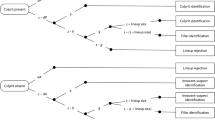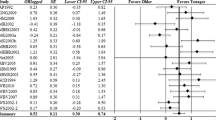Abstract
Past research has considered the impact of biased police lineup instructions upon eyewitness lineup performance. Biased instructions either suggest to the eyewitness that the perpetrator is in the lineup or otherwise discourage a “no choice” response. A meta-analysis of 18 studies was employed to review the hypothesis that biased instructions lead to greater willingness to choose and less accurate lineup identifications than do unbiased instructions. The role of moderating variables in the instruction procedure was also considered. In support of the hypothesis, a significantly higher level of choosing followed biased instructions. Lineup type moderated performance accuracy, however. For target-absent lineups the increased level of choosing following biased instructions resulted in reduced identification accuracy. Biased instructions within a target-present lineup generated a higher level of confidence, but had minimal impact on accuracy. Implications for police practice are discussed.
Similar content being viewed by others
REFERENCES
Asch, S. (1951). Effects of group pressure upon the modification and distortion of judgment. In H. Guetzkow (Ed.), Groups, leadership, and men (pp. 177–190). Pittsburgh, PA: Carnegie Press.
Buckhout, R., Figueroa, D., & Hoff, E. (1975). Eyewitness identification: Effects of suggestion and bias in identification from photographs. Journal of the Psychonomic Society, 6, 71–74.
Cohen, J. (1988). Statistical power analysis for the behavioral sciences (2nd ed.) Hillsdale, NJ: Erlbaum.
Cutler, B. L., & Penrod, S. D. (1988). Improving the reliability of eyewitness identification: Lineup construction and presentation. Journal of Applied Psychology, 73, 281–290.
Cutler, B. L., & Penrod, S. D. (1995). Mistaken identification: The eyewitness, psychology, and the law. New York: Cambridge University Press.
Cutler, B. L., Penrod, S. D., & Martens, T. K. (1987a). The reliability of eyewitness identification. Law and Human Behavior, 11, 233–258.
Cutler, B. L., Penrod, S. D., O'Rourck, T. E., & Martens, T. K. (1986). Unconfounding the effects of contextual cues on eyewitness identification accuracy. Social Behaviour, 1, 113–134.
Cutler, B. L., Penrod, S. D., & Martens, T. K. (1987b). Improving the reliability of eyewitness identification: Putting context into context. Journal of Applied Psychology, 72, 629–637.
Deutsch, M., & Gerard, H. B. (1955). A study of normative and informational social influence upon individual judgment. Journal of Abnormal and Social Psychology, 51, 629–636.
Devenport, J. L., & Fisher, R. P. (1995). The effect of authority and social influence on eyewitness suggestibility and person recognition. Unpublished manuscript.
Fleet, M. L., Brigham, J. C., & Bothwell, R. K. (1987). The confidence-accuracy relationship: The effects of confidence assessment and choosing. Journal of Applied Social Psychology, 17, 171–187.
Foster, R. A., Libkuman, T. M., Schooler, J. W., & Loftus, E. F. (1994). Consequentiality and eyewitness person identification. Journal of Applied Cognitive Psychology, 8, 107–121.
Hall, D. F., & Ostrom, T. M. (1975, August). Accuracy of eyewitness identification after biasing or unbiased instructions. Paper presented at the meeting of the American Psychological Association, Chicago.
Hilgendorf, E. L., & Irving, B. L. (1978). False positive identification. Medicine, Science, and the Law, 18, 255–262.
Hosch, H. M., Leippe, M. R., Marchioni, P. M., & Cooper, D. S. (1984). Victimization, self-monitoring, and eyewitness identification. Journal of Applied Psychology, 69, 280–288.
Kassin, S. M., Ellsworth, P. C., & Smith, V. L. (1989). The “general acceptance” of psychological research on eyewitness testimony. A survey of the experts. American Psychologist, 44, 1089–1098.
Kohnken, G., & Maass, A. (1988). Eyewitness testimony: False alarms on biased instructions? Journal of Applied Psychology, 73, 363–370.
Lindsay, R. C. L., Lea, J. A., & Fulford, J. A. (1991). Sequential lineup presentation: Technique matters. Journal of Applied Psychology, 76, 741–745.
Lindsay, R. C. L., Lea, J. A., Nosworthy, G. J., Fulford, J. A., Hector, J., LeVan, V., & Seabrook, C. (1991). Biased lineups: Sequential presentation reduces the problem. Journal of Applied Psychology, 76, 796–802.
Lindsay, R. C. L., & Wells, G. L. (1985). Improving eyewitness identifications from lineups: Simultaneous versus sequential lineup presentations. Journal of Applied Psychology, 70, 556–564.
Loftus, E. F. (1979). Eyewitness testimony. Cambridge, MA: Harvard University Press.
Loftus, E. F. (1993). The reality of repressed memories. American Psychologist, 48, 518–537.
Malpass, R. S., & Devine, P. G. (1981). Eyewitness identification: Lineup instructions and the absence of the offender. Journal of Applied Psychology, 66, 482–489.
Malpass, R. S., Devine, P. G., & Bergen, G. T. (1980). Eyewitness identification: Realism vs. the laboratory. Unpublished manuscript. State University of New York, Plattsburgh.
Milgram, S. L. (1965). Some conditions of obedience and disabedience to authority. Human Relations, 18, 57–76.
O'Rourke, T. E., Penrod, S. D., Cutler, B. L., & Stuve, T. E. (1989). The external validity of eyewitness identification research: Generalizing across subject populations. Law and Human Behavior, 13, 385–395.
Paley, B., & Geiselman, R. E. (1989). The effects of alternative photospread instructions on suspect identification performance. American Journal of Forensic Psychology, 7, 3–13.
Rattner, A. (1988). Convicted but innocent: Wrongful conviction and the criminal justice system. Law and Human Behavior, 12, 283–293.
Rosenthal, R. (1991). Meta-analytic procedures for social research. Newbury Park, CA: Sage.
Seelau, S. M., & Wells, G. L. (1995). Applied eyewitness research: The other mission. Law and Human Behavior, 19, 319–324.
Sporer, S. L. (1992). Eyewitness identification accuracy, confidence, and decision-times in simultaneous and sequential lineups. Journal of Applied Psychology, 78, 32–46.
Sporer, S. L. (1995). Choosing, confidence, and accuracy: A meta-analysis of the confidence-accuracy relation in eyewitness identification studies. Psychological Bulletin, 118, 315–327.
Stinson, V., Devenport, J. L., Cutler, B. L., & Kravitz, D. A. (1996). How effective is the presence-of-counsel safeguard? Attorney perceptions of suggestiveness, fairness, and correctability of biased lineup procedures. Journal of Applied Psychology, 81, 64–75.
Warnick, D. H., & Sanders, G. S. (1980). Why do eyewitnesses make so many mistakes? Journal of Applied Social Psychology, 10, 362–366.
Wells, G. L. (1978). Applied eyewitness testimony research: System variables and estimator variables. Journal of Personality and Social Psychology, 36, 1546–1557.
Wells, G. L. (1984). The psychology of lineup identifications. Journal of Applied Social Psychology, 14, 89–103.
Wells, G. L., Seelau, E. P., Rydell, S. M., & Luus, C. A. E. (1994). Recommendations for properly conducted lineup identification tasks. In D. F. Ross, J. D. Read, & M. P. Toglia (Eds.), Adult eyewitness testimony: Current trends and developments (pp. 223–244). New York: Cambridge University Press.
Author information
Authors and Affiliations
About this article
Cite this article
Steblay, N.M. Social Influence in Eyewitness Recall: A Meta-Analytic Review of Lineup Instruction Effects. Law Hum Behav 21, 283–297 (1997). https://doi.org/10.1023/A:1024890732059
Issue Date:
DOI: https://doi.org/10.1023/A:1024890732059




